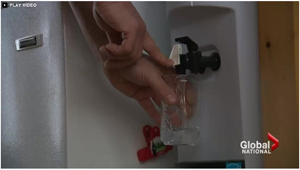THE WATER HALLER – Getting a Message Out Can be a Risky Game
![]() Print this Article | Send to Colleague
Print this Article | Send to Colleague
Our tagline at CWWA has been to be THE national voice for water and wastewater in Canada. We put a lot of effort into building awareness of our association to the media so, when a journalist is preparing a story on any water-related issues, they will call us for comment. Sometimes I will try to handle the response on my own, usually I will seek input from our technical committees or specific members ... or more often I defer the journalist directly to the best authority on that issue. Sometimes it works out for us and sometimes it doesn’t. For those of you who have to deal with the media, you know what I am talking about.
If you want to control your message, you are restricted to your own distribution channels — thus preaching to the converted. If you want to reach the general public, you have to work through the media — and thus give up all control.
I was involved in two national television interviews lately. Both consumed well over an hour of time preparing, then the camera set up, and finally 20 minutes of question and answer time. Then I wait until that evening to see my 3 to 6 seconds of fame that survived the editing cuts and made it into the story. I have learned they don’t much care for the details or the facts in their clips. In a story about flushable wipes, the CBC used many of the facts in their voice-over and focused on discussions with Barry Orr in London for a great news article. (My only air time was giggling about how I like plain old school toilet paper!)
In another story on the new Wastewater System Effluent Regulations, Global News started out investigating why Environment Canada would not release the list of which communities were ranked high, medium or low risk. They seemed determined from the start to prove that there was a conspiracy that threatened public drinking water. I, and several technical committee members, explained the difference between drinking water and wastewater, and explained the purpose of the new regulations, tried to eliminate any fears of unsafe drinking water, and even provided names of communities that were identified as high and medium risk. However, the reporter had determined the story in advance. The piece was titled "How Safe is Your Wastewater" but led with images of drinking water. She spoke to the mystery list that Environment Canada won’t share and then to confuse the issue more, went to a community that is dealing with high levels of uranium in their source water. (My clip was me saying "this is very serious" although I’m not sure what I was referring to?) I tried to follow up with some helpful comments that WSER, infrastructure renewal and uranium in a community’s drinking water were each interesting stories ON THEIR OWN, worthy of coverage, but together in a two-minute piece, they only served to confuse, mislead or even frighten the viewers. She disagreed.
Oh well, we’ll keep trying. Check these links to see the stories:
Is your wastewater system high risk? The feds won't tell you. |

